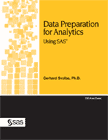Welcome to my new blog series Data Preparation (DP) and Data Quality (DQ) on the road. The main actors here are my two SAS books Data Preparation for Analytics Using SAS and Data Quality for Analytics Using SAS, which are allowed to accompany me to many conferences, SAS events, and private journeys. This blog series will include some background of places we’ll visit, SAS content, and last but not least some pictures of my books at these locations.
KSFE 2013

This year the KSFE – conference took place in Ulm. The KSFE is a German SAS user event and stands for “Conference for SAS in research and development”. It usually takes place at a university campus and is always a good place to meet SAS users from inside and outside the academic area and listen to statistical/analytical/methodological talks and have good discussions around these topics.
This year, I was invited to give two presentations; one on Getting an early picture about the quality status of your analysis data – SAS and JMP help you here and one about the SAS/JMP interface for structural equation modeling. While the first one obviously refers to my data quality book, the second is a rather new exotic topic for me but very powerful as the strong functionalities of the CALIS procedure in SAS/STAT are combined with an appealing graphical user interface in JMP.
Is this really the Danube?
The city of Ulm is a very nice old German city, centered around a very large and impressive dome. Close to the center, the Danube River is flowing. However I have to say that for an inhabitant of Vienna who is looking for the mighty Danube River, it is funny to see a tiny river, that obviously only expands when flowing north of the Austrian Alps and collects its water from there.
Where it all began

DP and DQ came with me and took their “grandfather” with them on the trip. Their grandfather is my PhD thesis Statistical Quality Control for Clinical Trials that was published in WUV in 1999. The nice coincidence with Ulm is that at the same university campus where the KSFE took place I also first presented my PhD in a very large auditorium. Actually we might say, that here in Ulm everything (presenting, conferencing, announcing, going public with my ideas) began in 1997 at the GMDS conference.
Elderly people and the young generation
As is often the case with the younger generation, DP and DQ got fed up with Grandfather's tales of bygone days and stopped listening to him. They missed Grandfather's words of wisdom: "In my time, everything was different. The young generation has things easier. I never got the chance to be an eBook, and I was only printed 100 times! And, most important, I didn't have a team of qualified publishing professionals at SAS Press (aka nice SAS Press ladies) taking care to promote me."
How was SAS in 1997?
Let’s leave emotions behind for a minute and think about how SAS looked in 1997. The actual version was 6.11 and was installed from a single (!) CD. You were only allowed to use 8 characters for variable and dataset names and there was no enhanced program editor or even SAS Enterprise Guide. When you wanted to create your own screen to enter parameters for a macros you had to program with SAS/AF and the screen control language (SCL), as stored processes and the creation of user prompts where not available at that time. Also the way to add customized tasks to a standard SAS Tool, like programming Custom Tasks for SAS Enterprise Guide as Chris Hemedinger describes in his book, was not available at that time. Not to speak of the hundreds of enhancements in options and functions in the SAS procedures and the SAS language or the way to easily and quickly create nice graphs with the SG-procedures or publish output with the Output Delivery System. So we allow grandfather to speak and we just nod understandingly when he talks about this time.

Look for future posts from SAS author Gerhard Svolba on this blog. Learn more about Gerhard and his two books Data Preparation for Analytics Using SAS and Data Quality for Analytics Using SAS here.

1 Comment
Thanks for your blogs and pictures (including this collection: http://bit.ly/1dBiBvR), Gerhard. I appreciate how clearly you communicate ideas as well as technical concepts.